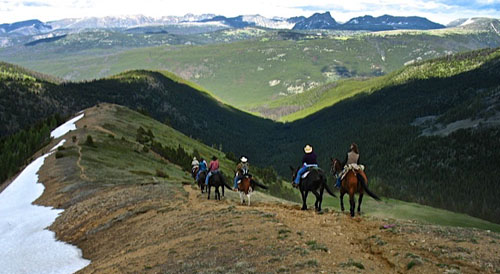|
Ten Year Packer Permits
Appeal still possible
by Karen West
After a 13-year process, the U.S. Forest Service has decided to give 10-year special-use permits to pack and saddle outfitters on the Methow, Chelan and Tonasket ranger districts.
The decision, signed March 25, also expands the number of use-days allowed, prohibits the expansion of existing destination camps and calls for camp management plans and monitoring of the largest camps in the Pasayten Wilderness to assure compliance with permit requirements.
The packers, who once had five-year permits, have been working on one-year permits since their five-year ones expired—in one case for the last 13 years.
 Steve Darwood, owner of Cascade Wilderness Outfitters, leads a group of clients from his camp above Crow Lake on a trail ride in the Pasayten Wilderness. Photo by Kit McLean Cramer. “We’re happy that it’s finally done,” said Jennifer Zbyszewski (pronounced pa-SHEF-ski), recreation, wilderness and facilities program manager for the Methow Valley Ranger District. “We hope the rest of the process goes smoothly". The 45-day appeal period ends May 13.
The decision calls for issuing 10-year permits to Cascade Corrals, Cascade Wilderness Outfitters, Deli Llama Wilderness Adventures, Early Winters Outfitting, North Cascade Outfitters, North Cascade Safaris and Sawtooth Outfitters. The outfitters offer destination trips to wilderness camps and day rides with pack support in the North Cascades and Alta Lake areas.
Rebecca Lockett Heath, forest supervisor for the Okanogan-Wenatchee National Forest, made the decision and issued a 25-page “Record of Decision” that details her rationale. Heath said the permits should bring stability to the outfitter business and allow room for growth.
But Brian Varrelman, owner of Sawtooth Outfitters based in Pateros, isn’t counting on receiving a 10-year permit soon. “It’s an ongoing process,” he told Grist, adding that the decision will stand “if it’s not contested” and could be some years away if objections are raised. “History has a way of repeating itself,” he said. “There are special interest groups out there that are going to appeal.”
Steve Darwood, owner of Cascade Wilderness Outfitters based in Carlton, has had a one-year permit each year for the last 13 years. “I’m excited about getting a 10-year permit,” he said, adding that he’s glad Heath chose that option from the list of four alternatives. Darwood also is a partner with his son, Jess Darwood, in North Cascade Outfitters.
The Forest Service decision calls for two amendments to the Okanogan Forest Plan. One would allow outfitters to use, but not expand, existing campsites regardless of size. However, five full-service camps larger than 5,250 sq. ft. would be subject to management plans and monitoring. They are the camps in the Pasayten Wilderness at Bald Mountain, Sheep Mountain, Beaver Creek, Crow Lake and Whistler (Middle Fork Pasayten River).
The second amendment would allow use of existing campsites “within 200 feet of meadows, lakes, streams and key interest areas in the Pasayten and Lake Chelan-Sawtooth wilderness areas.”
The outfitters affected by the ruling use approximately 99 campsites, 86 of which are within 200 feet of the features listed above, according to the Forest Service document. “Many of the 86 are in the most desirable locations, so allowing their use will allow the outfitters to continue offering the high quality camping experiences they have in the past,” the decision states.
 Heath said allowing the outfitters to use existing campsites within 200 feet of meadows, streams, lakes, and key interest areas, and prohibiting expansion of all campsites “will prevent degradation of wilderness character by avoiding new campsites and not increasing the current amount of barren core.” Heath said allowing the outfitters to use existing campsites within 200 feet of meadows, streams, lakes, and key interest areas, and prohibiting expansion of all campsites “will prevent degradation of wilderness character by avoiding new campsites and not increasing the current amount of barren core.”
She also stated that the second amendment “will avoid the possibility of new campsites being created in the future, under separate NEPA [National Environmental Policy Act] decisions, to compensate for what would be a lack of adequate sites.”
Heath’s decision also approves base camps outside the wilderness at Andrews Creek, Billygoat, Crater Creek and Slate Creek trailheads in the Methow Valley Ranger District and at Fish Creek Camp on the Chelan Ranger District. “Each location will have corrals, livestock watering troughs and other improvements to protect resources,” she wrote.
Heath also acknowledged that many of the outfitters’ clients are older and may not be able to experience the wilderness without pack support.
Darwood said he submitted two year’s worth of client records showing that “Eighty-five percent of my business was people 50 and older and seventy-five percent were 55 and older.”
He added that he used to have “more family business” and would like to see more parents getting their kids away from computers and out into the woods again.
The outfitters currently contribute about $1.3 million annually to the Okanogan County economy and provide 26.6 jobs, the Forest Service found. The option Heath chose could increase the contribution to $1.9 million and 40 jobs if demand increases to the levels allowed, she said.
Zbyszewski said in 1998 or 1999 the Methow Valley Ranger District received a complaint raising concerns about the impact outfitters were having on the wilderness environment. In response, she said the district started looking into the issues of permits and how to enforce them. A number of five-year permits were coming up for renewal.
Varrelman said outfitters represent only two percent of backcountry users but have been held to a higher standard than the heliskiers, snowmobilers and non-profit youth groups that also use the backcountry.
The Forest Service started the same review process for those other users, did environmental assessments and found “no significant impact,” he added. “That’s where it should have ended for us.” Instead, the Forest Service undertook a full federal Environmental Impact Statement.
Zbyszewsi said that in 2005 a lawsuit related to packer permits brought by hikers against a Forest Service jurisdiction in California resulted in an order to do a full Federal Environmental Impact Statement. “That decision didn’t apply to us… but we do react to court decisions in other parts of the country,” she said.
The National Park Service also had “run into some resistance to issuing pack and saddle permits,” she added, thus it was decided to do an Environmental Impact Statement before making a decision here on packing permits.
Asked why the decision took so long and whether it was possible to calculate the cost, Zbyszewski said there is no way to estimate the cost. “It has certainly not been [worked on] full time for the last 13 years,” she said. “It’s always been important but it has been bumped out of the first place position by wildfires and team members’ medical needs over the years.”
The full decision and appeals process can be found on the Okanogan-Wenatchee National Forest website. Scroll down to the “completed analysis” section and click on “Pack and Saddle Stock Outfitter-Guide Special Use Permits.”
3/30/2013
see past stories in the archive >>
|
